San Sebastian Cheesecake, also known as Burnt Basque Cheesecake, has been taking the culinary world by storm. Its unique burnt exterior and creamy, custard-like center make it stand out from traditional cheesecakes.
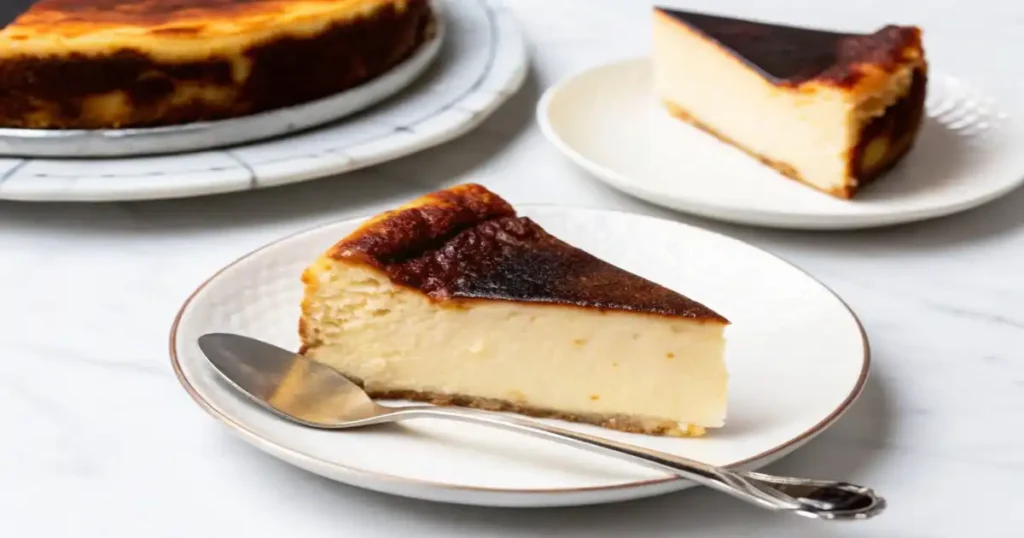
While it originated in San Sebastián, Spain, its popularity skyrocketed when a café in Istanbul, Turkey, started serving it with melted chocolate drizzled over the top. Since then, this cheesecake has become a global sensation.
If you have never tried making cheesecake before, this is the perfect recipe to start with. Unlike classic cheesecakes, this one requires no crust, no water bath, and no complicated techniques. The high baking temperature naturally creates a caramelized top, adding a subtle smokiness that enhances the flavor.
Let’s explore what makes this cheesecake unique and how you can make it at home with ease.
What Makes San Sebastian Cheesecake Special?
Unlike dense, structured cheesecakes, San Sebastian Cheesecake is light, creamy, and effortlessly rustic. Here’s why it is different:
- No crust – This cheesecake stands on its own without needing a biscuit or graham cracker base.
- Burnt caramelized top – Baked at a high temperature, the top develops a rich golden-brown layer that enhances the taste.
- Soft, custard-like texture – Instead of being firm, the center remains slightly jiggly, making it smooth and melt-in-your-mouth.
- Minimal ingredients, maximum flavor – Simple ingredients come together to create an indulgent treat.
Now, let’s go over everything you need to make this famous dessert at home.
San Sebastian Cheesecake Ingredients
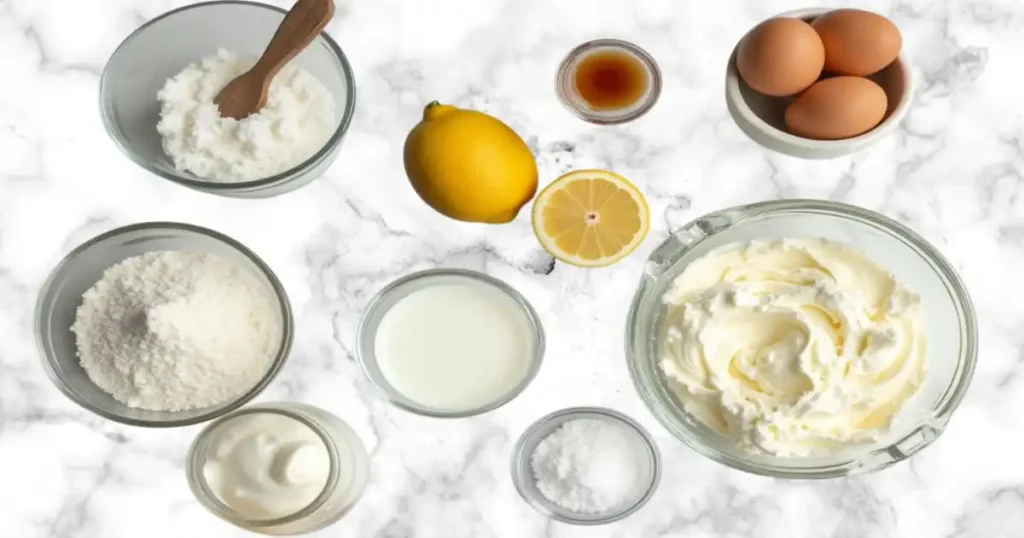
Core Ingredients
- 600g full-fat cream cheese (room temperature)
- 240g granulated sugar
- 40g cornstarch (or substitute with all-purpose flour)
- ½ teaspoon salt
- 200ml heavy whipping cream (or double cream)
- 100g plain Greek yogurt (or sour cream for added richness)
- 1 tablespoon lemon juice (optional, for slight tanginess)
- 1 tablespoon vanilla extract
- 4 large eggs (room temperature)
Optional Additions:
- Melted chocolate, caramel, or fruit compote for topping
Ingredient Notes:
- Cornstarch vs. Flour – Cornstarch makes the cheesecake softer and silkier, while flour adds structure.
- Yogurt or Sour Cream? – Yogurt keeps it light, whereas sour cream adds a deeper richness.
- Lemon Juice – This enhances the flavor but can be omitted for a more traditional taste.
San Sebastian Cheesecake Prep
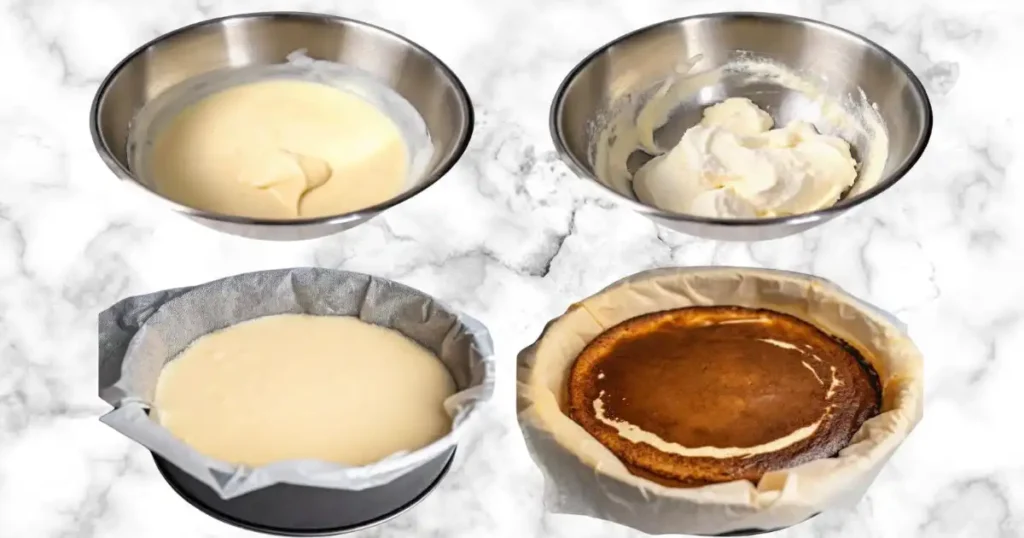
Step 1: Prepare the Pan and Preheat the Oven
- Set the oven to 400°F (200°C).
- Line an 8-inch round cake pan with parchment paper, leaving extra paper on the edges to help lift the cheesecake out after baking.
Step 2: Making the Batter
Blend the Base Ingredients
- In a large bowl, mix cream cheese, sugar, cornstarch, and salt using a hand mixer or stand mixer at low speed. Blend for about 2-4 minutes until smooth.
- Be careful not to overmix, as too much air can cause cracks.
Incorporate the Wet Ingredients
- Add half of the heavy cream, mix gently, then pour in the rest.
- Stir in yogurt, vanilla extract, and lemon juice, ensuring everything is well combined.
Add the Eggs
- One at a time, add the eggs, mixing at low speed after each addition.
- The batter should remain smooth and silky.
Strain for Extra Creaminess (Optional but Recommended)
- Pour the batter through a fine sieve to remove any lumps and air pockets. This step ensures a flawless texture.
Step 3: Baking the Cheesecake
- Pour the batter into the prepared pan.
- Bake at 400°F (200°C) for 40-50 minutes.
- The cheesecake is done when the edges are set, but the center still wobbles when shaken.
If the top has not browned enough, do not extend the baking time. Instead, switch the oven to broil for 1-2 minutes, monitoring closely to avoid burning.
Cooling and Setting the San Sebastian Cheesecake
Once baked, let the cheesecake sit at room temperature for an hour before transferring it to the refrigerator for at least 4-6 hours. Overnight chilling is ideal for the best consistency.
Why does chilling matter?
- It allows the texture to firm up while remaining creamy.
- The flavors develop further, making the cheesecake even more delicious.
Serving Suggestions
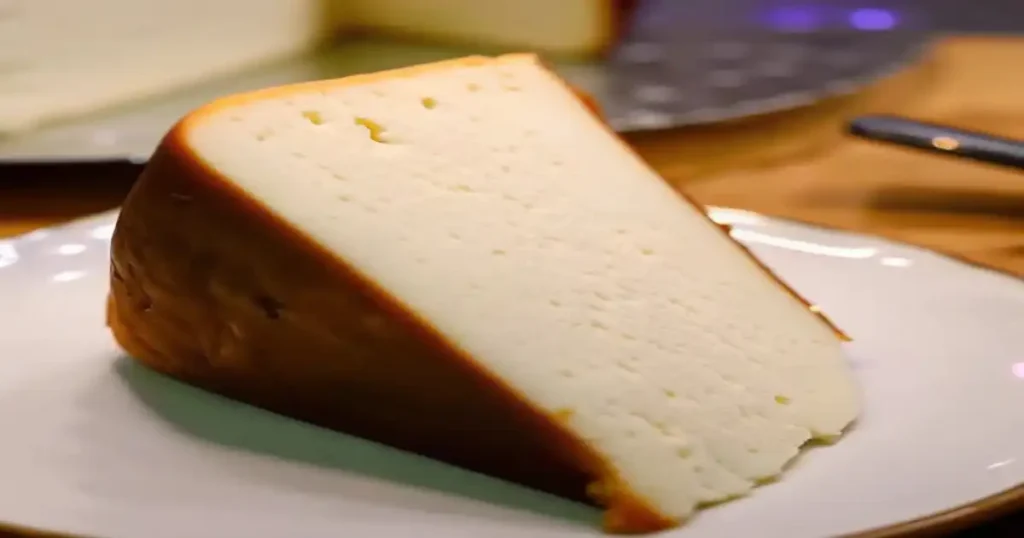
San Sebastian Cheesecake is incredibly versatile. You can enjoy it as is or customize it with toppings.
Classic Style (No Topping)
- The natural caramelized top is flavorful enough on its own.
Drizzled with Melted Chocolate
- Pour warm milk or dark chocolate over the top for a decadent touch.
Fruit Toppings
- Fresh berries, cherry compote, or citrus zest add a refreshing contrast.
Caramel or Honey Drizzle
- A thin layer of caramel or honey enhances the richness.
Expert Baking Tips
- Do not overbeat the batter – Too much air can cause cracks.
- Use parchment paper – This makes it easier to lift the cheesecake out after baking.
- Stick to high heat – The burnt top is a signature feature, so do not lower the temperature.
- Jiggly center means perfect texture – If the middle is completely firm, it may be overbaked.
Storage and Make-Ahead Tips
- Refrigerate – Store in an airtight container for up to five days.
- Freeze – Wrap tightly in plastic wrap and keep in the freezer for up to three months.
- Thawing – Place in the refrigerator overnight before serving.
Final Thoughts: Is This the Ultimate Cheesecake?
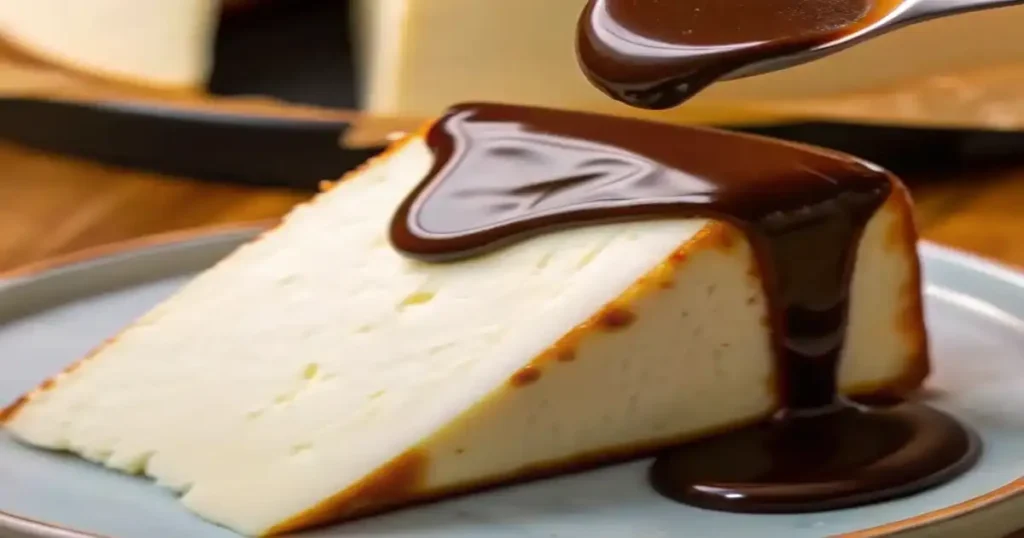
After making this cheesecake multiple times, it is clear why it has become a worldwide favorite.
San Sebastian Cheesecake is simple to make, incredibly creamy, and has a deep caramelized flavor that is hard to resist. Whether you enjoy it plain or topped with chocolate, it is a unique dessert that is worth every bite. After dinner or lunch, it also makes for a delicious and satisfying breakfast, providing a rich yet balanced start to your day.
For anyone hesitant about baking cheesecakes, this is the perfect starting point. There is no need for a water bath, no complicated steps, and the burnt exterior enhances the flavor rather than ruining it.
Recipe Recap
- No crust, no water bath, easy preparation
- Creamy, custard-like center with a caramelized top
- Requires chilling before serving for best results
- Customizable with chocolate, fruit, or caramel toppings
If you try this San Sebastian Cheesecake, share your thoughts and let me know how it turns out. Happy baking!
San Sebastian Cheesecake FAQs
San Sebastian Cheesecake is named after San Sebastián, Spain, where it was created at La Viña restaurant. Its burnt top and creamy texture made it famous worldwide. Though it originated in Spain, it gained global popularity, with many variations now available in cafés and bakeries around the world.
They are the same dessert with different names. “Basque Cheesecake” refers to the Basque Country, while “San Sebastian Cheesecake” highlights its city of origin. It has no crust, a caramelized top, and a custard-like texture, making it lighter than traditional cheesecakes. Some international versions include additional flavors and toppings.
No, it originated in San Sebastián, Spain. However, it became very popular in Turkey, especially in Istanbul, where cafés like Viyana Kahvesi serve it with melted chocolate. Social media helped spread its popularity, leading many to mistakenly believe it is Turkish, though it remains a Spanish dessert.
This cheesecake comes from San Sebastián, Spain, and was invented at La Viña restaurant by Chef Santiago Rivera in the 1990s. It is part of the Basque culinary tradition. Over time, it spread globally, becoming popular in Europe, the U.S., and Asia, with various adaptations and toppings.
Related Desserts to Try
- Mochi Donuts: A chewy, trendy dessert that has gained global popularity for its unique texture and delightful sweetness.
- Knefeh: A rich, cheesy Middle Eastern dessert soaked in syrup, best enjoyed with coffee or tea.
- Homemade Popeyes Biscuits: Buttery, flaky biscuits that make a perfect companion for breakfast or a snack.
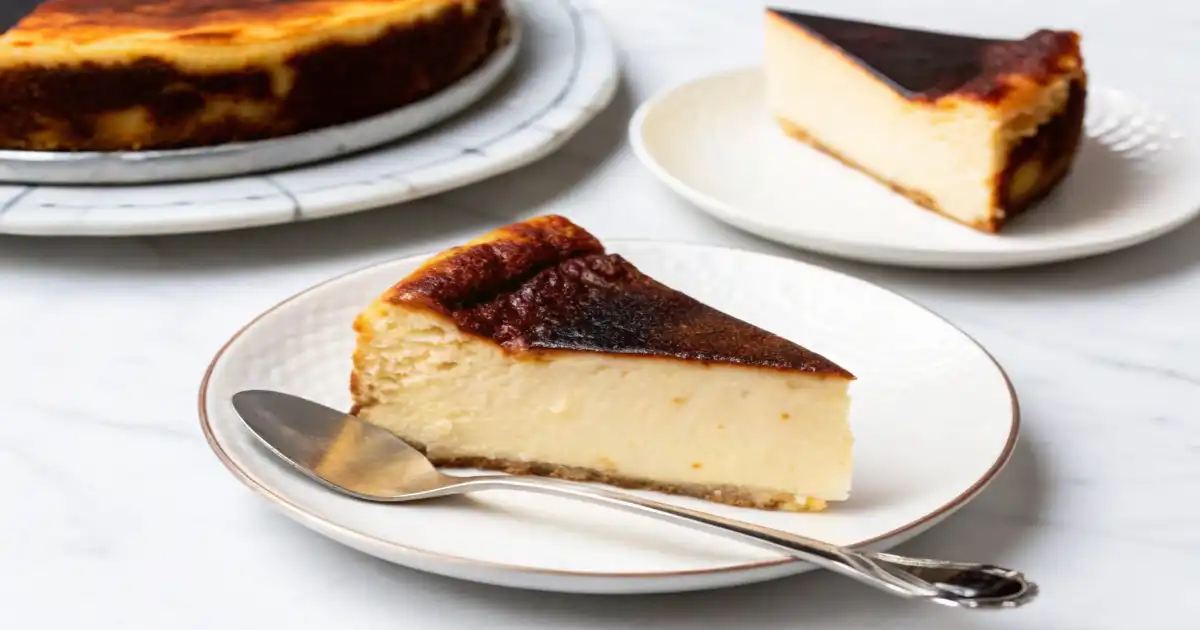
San Sebastian Cheesecake (Burnt Basque Cheesecake)
Ingredients
Cheesecake Batter
- 600 g full-fat cream cheese room temperature
- 240 g granulated sugar
- 40 g cornstarch or all-purpose flour
- ½ teaspoon salt
- 200 ml heavy whipping cream
- 100 g plain Greek yogurt or sour cream
- 1 tablespoon lemon juice optional
- 1 tablespoon vanilla extract
- 4 large eggs room temperature
Optional Toppings
- Melted chocolate or caramel
- Fresh berries or citrus zest
- Honey drizzle
Instructions
Step 1: Prepare the Pan and Preheat the Oven
- Preheat oven to 400°F (200°C).
- Line an 8-inch round cake pan with parchment paper, ensuring extra overhang to lift the cheesecake out after baking.
Step 2: Make the Cheesecake Batter
- Blend the Base Ingredients
- In a large mixing bowl, beat together cream cheese, sugar, cornstarch, and salt for 2-4 minutes on low speed until smooth.
- Do not overmix to avoid excess air bubbles.
- Incorporate the Wet Ingredients
- Gradually mix in half of the heavy cream, then add the rest.
- Stir in Greek yogurt, vanilla extract, and lemon juice until well combined.
- Add the Eggs
- Add eggs one at a time, mixing at low speed after each addition.
- The batter should be silky and smooth.
- Strain for Extra Creaminess (Optional but Recommended)
- Pour the batter through a fine sieve to remove lumps for an ultra-smooth texture.
Step 3: Bake the Cheesecake
- Pour the batter into the prepared pan.
- Bake at 400°F (200°C) for 40-50 minutes.
- The cheesecake should have a deep golden-brown top while the center remains slightly wobbly.
- If the top isn’t browned enough, broil for 1-2 minutes while monitoring closely.
Step 4: Cool and Set
- Let the cheesecake cool at room temperature for 1 hour.
- Transfer to the refrigerator for at least 4-6 hours (overnight is best).
Serving Suggestions
- Classic Style: Enjoy plain with its rich, caramelized top.
- Chocolate Drizzle: Pour melted chocolate over the cheesecake for a decadent twist.
- Fresh Fruit: Top with berries or a citrus zest garnish for freshness.
- Caramel or Honey: Drizzle lightly for extra richness.
Tips for the Perfect San Sebastian Cheesecake
- Use parchment paper – Ensures easy removal after baking.
- Stick to high heat – The burnt top is a signature feature.
- Do not overbeat – Too much air causes cracks.
- Jiggly center is key – If it’s fully set, it may be overbaked.
- San Sebastian Cheesecake is rich, creamy, and incredibly easy to make. Unlike traditional cheesecakes, this one requires no crust and no water bath—just mix, bake, and chill! Its burnt caramelized top enhances the flavor, making every bite irresistible.
